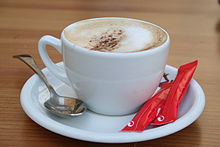food.wikisort.org - Beverage
Café con leche ('coffee with milk') is a coffee beverage common throughout Spain and Latin America consisting of strong coffee (usually espresso) mixed with scalded milk in approximately equal amounts. The amount of milk can be higher in a café con leche en vaso or a café con leche de desayuno.[1] Sugar or sweetener is added to taste. It is similar to the Italian caffè latte and the French café au lait.
 Café con leche from Lugo, Spain | |
| Alternative names | Cafebar |
|---|---|
| Course | Beverage |
| Place of origin | Spain |
| Serving temperature | Hot |
| Main ingredients | Coffee, milk |
| Variations | Café au lait, caffè e latte |
Origin
The cafe con leche drink originated in Spain, though it is unclear who or when this drink was first created. [2] After becoming popular in Spain, this coffee beverage has spread to other Spanish-speaking countries and areas. Café con leche is very common in Spain and Latin America, as well as other Latin American communities around the world.
Cuban restaurants in Florida often have a walk-up window (ventanita) that serve café con leche.[3]
Current use
Café con leche is considered a breakfast drink in many countries that serve it. Because of the milk, it is heavier and more filling than coffee drinks.[4]
The drink is created by making espresso and then using a steam wand scalding milk to just below the boiling point. Often sugar is added to the milk as it is being heated. The warmed milk is then poured over the espresso and stirred.[2]
Serving Styles
- Café con leche can be clarito (light, more milk) or oscurito (dark, less milk).[5]
- Sometimes a little salt is added.[5]
- Café con leche is typically served hot, but can also be made iced.
- Whole dairy milk is the usual, but other types of dairy and non-dairy milks can be used, with a change in taste and texture.[2]
- The amount of sugar used varies.[4]
- A cafe con leche ordered yo lo preparo consists of espresso and steamed milk served separately, and mixed by the consumer.[6]

Prepared café con leche
Café con leche coffee pods,[7] instant coffee,[8][9] and canned coffee[10] are available.
See also
 Coffee portal
Coffee portal
References
- Coffee Supremacy: Spanish Latte
- Kanniah, Janice Chinna (2020-09-14). "What Is A Café Con Leche?". Perfect Daily Grind. Retrieved 2020-11-18.
- "Best Café Con Leche: Tinta y Café | Best of Miami® 2017: Your Key to the City". Miami New Times. Retrieved 2020-11-18.
- "How to Make a Cafe Con Leche (Recipe)". Espresso & Coffee Guide. Retrieved 2020-11-18.
- Frías, Carlos (Mar 21, 2018). "Cuban Coffee 101: Everything to know about ordering coffee in Miami". Miami Herald. Retrieved 17 Nov 2020.
- Sentinel, Viviana Carballo, Special to the. "CAFE CON LECHE". OrlandoSentinel.com. Retrieved 2020-11-18.
- "Café con Leche Flavored K-Cup® Pods". Café Bustelo®. Retrieved 2021-04-06.
- "Café con Leche Artificially Flavored Instant Coffee Beverage Mix". Café Bustelo®. Retrieved 2021-04-06.
- "Instant Coffee, Recipes and More | NESCAFÉ®". www.nescafe.com. Retrieved 2021-04-06.
- "Café con Leche Ready to Drink Espresso Coffee". Café Bustelo®. Retrieved 2021-04-06.
Другой контент может иметь иную лицензию. Перед использованием материалов сайта WikiSort.org внимательно изучите правила лицензирования конкретных элементов наполнения сайта.
WikiSort.org - проект по пересортировке и дополнению контента Википедии